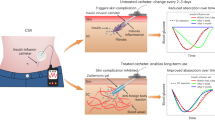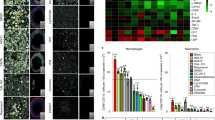Abstract
Patients with diabetes mellitus (DM) frequently require multiple painful injections of insulin to manage their blood glucose level. A newly introduced, modified titanium implant, the implant-mediated drug delivery system (IMDDS), has the advantage of sustained, needle-free drug delivery. We evaluated the feasibility of the IMDDS as an alternative route of insulin delivery in an alloxan-induced rabbit DM model. Among a total of 30 rabbits with IMDDSs, 25 survived the induction and had a blood glucose level (BGL) higher than 300 mg/dl. The animals were divided into two groups: 13 in the test group to which insulin was administered via the IMDDS and 12 in the untreated control group. The BGL was monitored and measured at 0, 2, 4, 6, 8, 12, and 24 hours on the first day and every 12 hours thereafter for a total of 2 weeks. Marked hypoglycemic effects of insulin in the test rabbits were detected from the 2-h time point, and the mean BGL fell below the normal range from 12 h after insulin administration via the IMDDS. The effects lasted the entire 2-week period. Control rabbits did not show a pronounced decrease in BGL except for three animals who exhibited spontaneous recovery. The mean body weight of the test group was significantly higher than that of the control group at the end of the observation period. Although this implant requires several improvements, the IMDDS exhibited promise as an alternative route of insulin delivery with the advantages of being a sustained, needle-free insulin delivery system.



Similar content being viewed by others
References
Tahrani AA, Bailey CJ, Del Prato S, Barnett AH. Management of type 2 diabetes: new and future developments in treatment. Lancet. 2011;378:182–97.
Tuomi T et al. The many faces of diabetes: a disease with increasing heterogeneity. Lancet. 2014;383:1084–94.
Chen H, Lan HY, Roukos DH, Cho WC. Application of microRNAs in diabetes mellitus. J Endocrinol. 2014;222:R1–R10.
Le Floch JP. Critical appraisal of the safety and efficacy of insulin detemir in glycemic control and cardiovascular risk management in diabetics. Diabetes Metab Syndr Obes. 2010;3:197–213.
Aye MM, Atkin SL. Patient safety and minimizing risk with insulin administration—role of insulin degludec. Drug Healthc Patient Saf. 2014;6:55–67.
Dailey G. New strategies for basal insulin treatment in type 2 diabetes mellitus. Clin Ther. 2004;26:889–901.
Garvey WT, Olefsky JM, Griffin J, Hamman RF, Kolterman OG. The effect of insulin treatment on insulin secretion and insulin action in type II diabetes mellitus. Diabetes. 1985;34:222–34.
Robertson RP, Olson LK, Zhang HJ. Differentiating glucose toxicity from glucose desensitization: a new message from the insulin gene. Diabetes. 1994;43:1085–9.
Tomar L et al. In vivo evaluation of a conjugated poly (lactide-ethylene glycol) nanoparticle depot formulation for prolonged insulin delivery in the diabetic rabbit model. Int J Nanomedicine. 2013;8:505–20.
Smart AL, Gaisford S, Basit AW. Oral peptide and protein delivery: intestinal obstacles and commercial prospects. Expert Opin Drug Deliv. 2014;11:1323–35.
Berlin I et al. Phobic symptoms, particularly the fear of blood and injury, are associated with poor glycemic control in type I diabetic adults. Diabetes Care. 1997;20:176–8.
Sadrzadeh N, Glembourtt MJ, Stevenson CL. Peptide drug delivery strategies for the treatment of diabetes. J Pharm Sci. 2007;96:1925–54.
Onuki Y, Morishita M, Takayama K. Formulation optimization of water-in-oil-water multiple emulsion for intestinal insulin delivery. J Control Release. 2004;97:91–9.
Owens DR. New horizons—alternative routes for insulin therapy. Nat Rev Drug Discov. 2002;1:529–40.
Sullivan CO, Birkinshaw C. In vitro degradation of insulin-loaded poly (n-butylcyanoacrylate) nanoparticles. Biomaterials. 2004;25:4375–82.
Park YS, Cho JY, Lee SJ, Hwang CI. Modified titanium implant as a gateway to the human body: the implant mediated drug delivery system. Biomed Res Int. 2014;2014:801358.
Wang J et al. Creating a long-term diabetic rabbit model. Exp Diabetes Res. 2010;2010:289614.
Team RDC. 2015 R: A language and environment for statistical computing. Vienna, Austria: R Foundation for Statistical Computing.
Park YS, Chang MS, Lee SP. Three-dimensional topography of the gingival line of young adult maxillary teeth: curve averaging using reverse-engineering methods. Int J Oral Maxillofac Implants. 2011;26:1217–24.
Chung SH, Kim HK, Shon WJ, Park YS. Peri-implant bone formations around (Ti,Zr) O2-coated zirconia implants with different surface roughness. J Clin Periodontol. 2013;40:404–11.
Park YS, Chung SH, Shon WJ. Peri-implant bone formation and surface characteristics of rough surface zirconia implants manufactured by powder injection molding technique in rabbit tibiae. Clin Oral Implants Res. 2013;24:586–91.
Leveque D. Subcutaneous administration of anticancer agents. Anticancer Res. 2014;34:1579–86.
Zimmet PZ, Magliano DJ, Herman WH, Shaw JE. Diabetes: a 21st century challenge. Lancet Diabetes Endocrinol. 2014;2:56–64.
McConnell EL, Fadda HM, Basit AW. Gut instincts: explorations in intestinal physiology and drug delivery. Int J Pharm. 2008;364:213–26.
Alberti KG, Zimmet PZ. Diabetes: a look to the future. Lancet Diabetes Endocrinol. 2014;2:e1–2.
Park JH, Cha HS, Kim HK, Park YS. Dexamethasone delivery by an implant-mediated drug delivery system in the canine mandible. J Periodontol. 2016;87:700–5.
Cha S, Kim HK, Kho HS, Park YS 2016. The sustained effects of pilocarpine hydrochloride in gelatin hydrogel administered by an implant-mediated drug delivery system. Curr Drug Deliv.
Dev SP, Stefan RA, Saun T, Lee S. Videos in clinical medicine. Insertion of an intraosseous needle in adults N Engl J Med. 2014;370:e35.
Acknowledgements
We thank S.J. Lindauer of Virginia Commonwealth University for reading the manuscript.
Author information
Authors and Affiliations
Corresponding author
Ethics declarations
Animal selection, management, and surgical protocols were conducted according to routines approved by the Institutional Animal Care and Use Committee of Seoul National University, Seoul, Korea.
Funding
This research was supported by a grant from the Korea Health Technology R&D Project through the Korea Health Industry Development Institute (KHIDI), funded by the Ministry of Health and Welfare, Republic of Korea (grant no. H I13C1474).
Conflict of interest
The authors declare that they have no conflict of interest.
Electronic supplementary material

Appendix
Fig. 1 Blood glucose level during the diabetic induction using alloxan for two weeks. Bars indicate 95% confidence interval of the mean. (GIF 24 kb)
Appendix
Fig. 2 Weight changes during experiment. The test group showed a significant weight gain. Bars indicate 95% confidence interval of the mean. (GIF 10 kb)
Rights and permissions
About this article
Cite this article
Park, YS. Novel route of insulin delivery using an implant-mediated drug delivery system. Drug Deliv. and Transl. Res. 7, 286–291 (2017). https://doi.org/10.1007/s13346-016-0354-3
Published:
Issue Date:
DOI: https://doi.org/10.1007/s13346-016-0354-3




